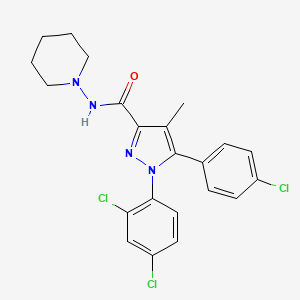



1. Acomplia
2. N-(piperidin-1-yl)-5-(4-chlorophenyl)-1-(2,4-dichlorophenyl)-4-methyl-1h-pyrazole-3-carboxamide Hydrochloride
3. Rimonabant Hydrochloride
4. Sr 141716
5. Sr 141716a
6. Sr-141716a
7. Sr141716
8. Sr141716a
9. Zimulti
1. 168273-06-1
2. Acomplia
3. Zimulti
4. 5-(4-chlorophenyl)-1-(2,4-dichlorophenyl)-4-methyl-n-(piperidin-1-yl)-1h-pyrazole-3-carboxamide
5. Sr141716
6. Rimoslim
7. Sr 141716
8. Sr141716a
9. Sr-141716a
10. A 281
11. Rimonabant Free Base
12. 5-(4-chlorophenyl)-1-(2,4-dichlorophenyl)-4-methyl-n-piperidin-1-ylpyrazole-3-carboxamide
13. Sr-141716
14. Rml78en3xe
15. Chembl111
16. Rimonabant (sr141716)
17. Chebi:34967
18. Ncgc00164572-01
19. Sr-14171
20. [3h]sr141716a
21. 158681-13-1 (hcl)
22. [3h]rimonabant
23. Dsstox_cid_26453
24. Dsstox_rid_81627
25. Dsstox_gsid_46453
26. 5-(4-chlorophenyl)-1-(2,4-dichlorophenyl)-4-methyl-1h-pyrazole-3-carboxylic Acid Piperidin-1-ylamide
27. Acomplia (tn)
28. Rimonabant [inn]
29. Smr003500713
30. Cas-168273-06-1
31. Unii-rml78en3xe
32. Rimonabant (jan/usan/inn)
33. Rimonabant [usan:inn:jan]
34. 5-(4-chlorophenyl)-1-(2,4-dichlorophenyl)-4-methyl-n-1-piperidinyl-1h-pyrazole-3-carboxamide
35. Rimonabant- Bio-x
36. 1h-pyrazole-3-carboxamide, 5-(4-chlorophenyl)-1-(2,4-dichlorophenyl)-4-methyl-n-1-piperidinyl-
37. Sr141,716a
38. Rimonabant [mi]
39. Rimonabant [jan]
40. 1h-pyrazole-3-carboxamide, 5-(4-chlorophenyl)-1-(2,4-dichlorophenyl)-4-methyl-n-1-piperidinyl-, Monohydrochloride
41. Rimonabant - From Sample
42. Rimonabant [usan]
43. Rimonabant(sr141716)
44. Rimonabant [mart.]
45. 5-(p-chlorophenyl)-1-(2,4-dichlorophenyl)-4-methyl-n-piperidinopyrazole-3-carboxamide
46. Rimonabant [who-dd]
47. Schembl38637
48. Gtpl743
49. Mls004774043
50. Mls006011772
51. Rimonabant [ema Epar]
52. Dtxsid3046453
53. Bdbm21278
54. Ex-a688
55. Hms3604m05
56. Hms3657o15
57. Bcp07803
58. Zinc1540228
59. Tox21_112200
60. Ac-731
61. Bbl030198
62. Mfcd04034714
63. Nsc791533
64. S3021
65. Stk642500
66. Akos005266728
67. Tox21_112200_1
68. Am84578
69. Ccg-269385
70. Cs-0645
71. Db06155
72. Nsc-791533
73. Sb19549
74. 5-(4-chlorophenyl)-1-(2,4-dichlorophenyl)-4-methyl-n-(1-piperidyl)pyrazole-3-carboxamide
75. 5-(4-chlorophenyl)-1-(2,4-dichlorophenyl)-4-methyl-n-piperidino-1h-pyrazole-3-carboxamide
76. Ncgc00164572-02
77. As-37280
78. Br164345
79. Hy-14136
80. Ac-163720
81. Db-011649
82. B1429
83. Ft-0631194
84. R0205
85. Sw220167-1
86. 81r131
87. D05731
88. Ab01566860_01
89. A810956
90. L000572
91. Q412529
92. Sr-01000884001
93. J-010440
94. Sr-01000884001-1
95. (n-(piperidin-1-yl)-5-(4-chlorophenyl)-4-methyl-1h-pyrazole-3-carboxamide
96. 5-(4-chlorophenyl)-1-(2,4-dichlorophenyl)-4-methyl-n-(1-piperidinyl)-3-pyrazolecarboxamide
97. 5-(4-chlorophenyl)-1-(2,4-dichlorophenyl)-4-methyl-n-piperidin-1-yl-pyrazole-3-carboxamide
98. N-piperidino-5-(4-chlorophenyl)-1(2,4-dichlorophenyl)-4-methyl-pyrazole-3-carboxamide
99. N-piperidino-5-(4-chlorophenyl)-1-(2,4-dichlorophenyl)-4-methyl-3-pyrazolecarboxamide
100. 1h-pyrazole-3-carboxamide,5-(4-chlorophenyl)-1-(2,4-dichlorophenyl)-4-methyl-n-1-piperidinyl-
101. 5-(4-chlorophenyl)-1-(2,4-dichloro-phenyl)-4-methyl-1h-pyrazole-3-carboxylic Acid Piperidin-1-ylamide
102. Ay6
| Molecular Weight | 463.8 g/mol |
|---|---|
| Molecular Formula | C22H21Cl3N4O |
| XLogP3 | 6.5 |
| Hydrogen Bond Donor Count | 1 |
| Hydrogen Bond Acceptor Count | 3 |
| Rotatable Bond Count | 4 |
| Exact Mass | 462.078094 g/mol |
| Monoisotopic Mass | 462.078094 g/mol |
| Topological Polar Surface Area | 50.2 Ų |
| Heavy Atom Count | 30 |
| Formal Charge | 0 |
| Complexity | 583 |
| Isotope Atom Count | 0 |
| Defined Atom Stereocenter Count | 0 |
| Undefined Atom Stereocenter Count | 0 |
| Defined Bond Stereocenter Count | 0 |
| Undefined Bond Stereocenter Count | 0 |
| Covalently Bonded Unit Count | 1 |
For use in conjunction with diet and exercise for patients with a body mass index greater than 30 kg/m2, or patients wih a BMI greater than 27 kg/m2 with associated risk factors, such as type 2 diabetes or dyslipidaemia.
As an adjunct to diet and exercise for the treatment of obese patients (BMI 30 kg/m2), or overweight patients (BMI 27 kg/m2) with associated risk factor(s), such as type 2 diabetes or dyslipidaemia (see section 5. 1).
As an adjunct to diet and exercise for the treatment of obese patients (BMI 30 kg/m2), or overweight patients (BMI 27 kg/m2) with associated risk factor(s), such as type 2 diabetes or dyslipidaemia (see section 5. 1).
In the RIO-North America trial, 3040 patients were randomized to receive either placebo or one of two doses of rimonabant (5 mg or 20 mg per day). Patients taking 20 mg rimonabant had significant weigh loss, decrease in waist circumference, improved insulin sensitivity, and increases in HDL cholesterol, compared to patients on placebo.
Anti-Obesity Agents
Agents that increase energy expenditure and weight loss by neural and metabolic regulation. (See all compounds classified as Anti-Obesity Agents.)
Cannabinoid Receptor Antagonists
Compounds that inhibit or block the activity of CANNABINOID RECEPTORS. (See all compounds classified as Cannabinoid Receptor Antagonists.)
A08AX01
A08AX01
A - Alimentary tract and metabolism
A08 - Antiobesity preparations, excl. diet products
A08A - Antiobesity preparations, excl. diet products
A08AX - Other antiobesity drugs
A08AX01 - Rimonabant
Absorption
Undetermined
Hepatic, CYP3A4 involved.
6 to 9 days with normal BMI and 16 days if BMI is greater than 30
Rimonabant is a specific CB1 cannabinoid receptor antagonist. There is considerable evidence that the endocannabinoid (endogenous cannabinoid) system plays a significant role in appetitive drive and associated behaviours. It is therefore reasonable to hypothesize that the attenuation of the activity of this system would have therapeutic benefit in treating disorders that might have a component of excess appetitive drive or over-activity of the endocannabinoid system, such as obesity, ethanol and other drug abuse, and a variety of central nervous system and other disorders.